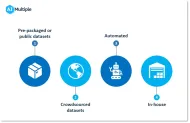Video data is crucial for training computer vision (CV) systems, particularly with the increasing demand for autonomous vehicles and CV-enabled technologies. Here, we explore what video data collection entails, the challenges involved, and best practices to consider.
What is video data collection for AI?
Video data collection for AI/ML training is the process of gathering video-object-detection systems, a specific type of video data, to train and deploy a CV system.
A video dataset can include clips of people, animals, objects, environments, etc. For instance, a video dataset to train a self-driving car might include clips of:
- Different vehicles are driving on the road,
- People crossing the road or walking on the sidewalk,
- Animals or pets crossing the road or on the sidewalk
- Other objects on the road or sidewalk (such as street signs, barriers, etc.)
You can also work with a video data collection service provider.
Video data collection challenges
Data collectors who collect video data might face the following challenges:
1. Cost of collection
Collecting video data can be expensive, especially when the dataset is supposed to be large. Even though smartphones are readily available for recording videos, the resulting recordings can be of low resolution. Therefore, data collectors must use expensive cameras to capture high-quality recordings.
In addition, recording videos on a large scale requires extra labor, which can be an expensive process for diverse datasets.
2. Time-consuming
Gathering video data can be time-consuming since it takes longer to record than image data.
For instance, if a CV-enabled security surveillance system requires data to be collected at a specific time of day (such as dawn), then collecting such data will take significantly longer compared to data collected during the daytime. This is because the data collector will have a limited time window to record such videos. This issue might also arise for image data collection; however, taking photos takes significantly less time than recording videos.
3. Unbiased/diverse data collection
A study by Georgia Tech identified that computer vision systems are surprisingly good at detecting pedestrians with light skin color.1 With autonomous vehicles, this kind of discrimination can be fatal if the technology doesn’t detect people of different skin colors. For instance, Tesla’s system did not recognize horse carriages on the road because the system was never trained with video data of horse carriages.2
Therefore, collecting diverse video data to avoid such biases and errors can become a challenge, even for large companies such as Tesla, when done in-house.
4. Privacy concerns
A major issue surrounding video data collection is privacy. With so much video being recorded in public spaces, workplaces, and even homes, there are genuine concerns about how this data is used and who has access to it.
Regulations like the GDPR (General Data Protection Regulation) in Europe have been implemented to protect individuals’ privacy, but there is still a delicate balance between harnessing the power of video data and respecting personal privacy.
5. Data storage and management
Video data requires vast amounts of storage space, particularly when collected continuously over extended periods. Storing, managing, and securing this data can be expensive and technically challenging for businesses and organizations. Cloud storage solutions have alleviated some of these challenges, but they come with their own costs and potential security risks.
6. Data overload
The sheer volume of video data being collected can lead to data overload. Without the right tools and technologies, it can be overwhelming for businesses to sift through hours of footage to find the insights they need. This is where AI and machine learning become essential, as they allow for the automated analysis of video data at scale.
Video data collection best practices
While collecting video data, you can consider the following best practices:
1. Automate video data collection
Video data collection can be automated by using web scraping tools. The user can set parameters for the required data that each video should have, allowing the scraper bot to gather the relevant data specifically from the internet.
2. Leverage crowdsourcing
Another effective method of gathering diverse and large datasets is through crowdsourcing.
Through a crowdsourcing model, contributors around the world can be hired through a platform to complete mini video data collection tasks. There are third-party crowdsourcing data collection specialists for companies to reach out to, thereby avoiding the hassle of developing a crowdsourcing platform in-house.
More on crowdsourcing data
3. Consider ethical and legal factors
Like every other type of data, gathering video data can also have some legal and ethical baggage. For instance, collecting videos of people for a face detection system can be subject to specific rules and policies that are important to consider in countries such as the US.
More on data collection ethics.
4. Ensure data quality
While collecting video data, maintaining the quality level is crucial for the overall performance of the CV system.
The video data should be:
- Recorded with consistency – i.e., with similar resolution, light variations, angles, etc.
- Recorded with diversity in mind. The data should be comprehensive and all-inclusive regarding the subject for which it is being collected.
- The video data should be authentic and should not have been physically or digitally modified.
More on quality assurance while gathering data.
You can also review our data-driven list of data collection and harvesting services to find the option that best suits your project needs.


Comments
Your email address will not be published. All fields are required.